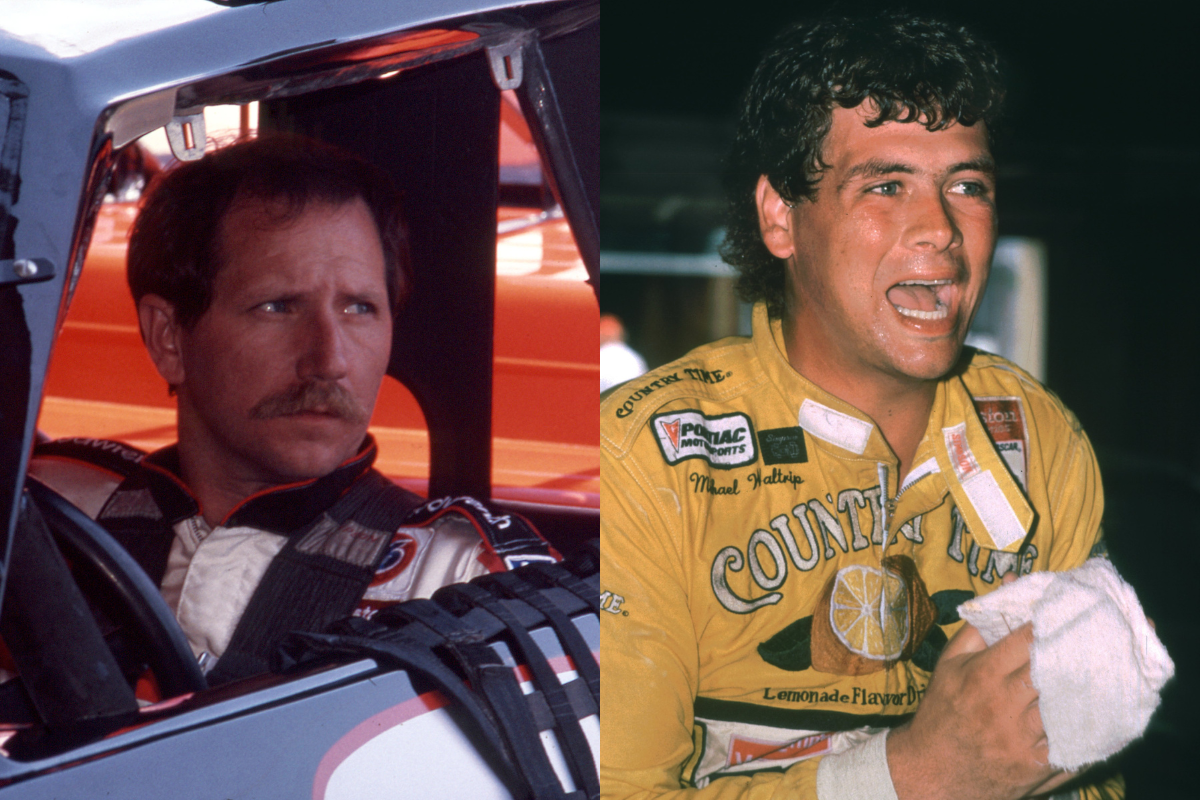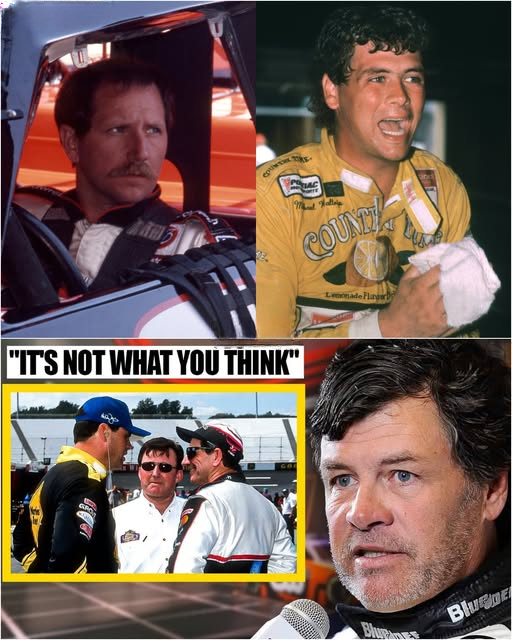
On February 18, 2001, Michael Waltrip finally achieved what seemed impossible: after 462 winless starts, he captured the checkered flag at the Daytona 500, NASCAR’s most coveted prize. But the day that should have marked the pinnacle of his career instead became the moment that changed his life forever. The reason? Dale Earnhardt—the man who believed in Waltrip when few others did, the legend who put him in a winning car—was gone.
For nearly a decade, Waltrip kept silent about what really happened that day. Now, more than twenty years later, he’s ready to speak up, sharing the truth about the plan, the race, and the loss that still haunts him: “To this day, I can’t explain it.”
From Perennial Underdog to Daytona Hopeful
For years, Michael Waltrip was NASCAR’s lovable underdog. The younger brother of champion Darrell Waltrip, Michael was well-liked in the garage and a favorite among sponsors, but he was also the driver who couldn’t win. Four hundred sixty-two races, zero victories—a streak that defined his career and, in many ways, his identity.
Everything changed in the fall of 2000, when Dale Earnhardt saw something in Waltrip that others had missed. Earnhardt, already a racing icon, struck a sponsorship deal with NAPA Auto Parts and put Waltrip in a third Dale Earnhardt Inc. (DEI) car for the 2001 season. For Waltrip, it was the break he’d waited his whole life for. “I finally got the ride I need,” he recalled. “I believe this is the ride I can go win races with.”
The pressure was off. For the first time, Waltrip had championship-caliber equipment and a mentor who believed in him. But even during Speedweeks at Daytona, setbacks threatened his confidence. A missed shift in his qualifying race seemed to ruin his momentum, but Earnhardt wouldn’t let him dwell on it. “I don’t care about that,” Earnhardt told him. “I want to talk about how we’re going to win this race.”

The Plan: Teamwork Over Glory
That Friday conversation between Waltrip and Earnhardt was more than a pep talk—it was a strategy session that defined the race and, ultimately, Waltrip’s life. Earnhardt knew Daytona was unpredictable; no one driver could win alone. “It’s going to take teamwork,” he said. “Me and you and Dale Jr. are going to win it. We’re going to work together.”
For Waltrip, this was more than just a race plan. It was Earnhardt, the Intimidator, putting his reputation and experience on the line for his teammate. Waltrip left that meeting with a confidence he’d never felt before. “I wasn’t just driving for myself anymore,” he said. “I was driving for Dale Earnhardt.”
By Sunday morning, Waltrip was ready. He described it as “the most peaceful morning I’d ever spent in my life.” The grid walk with Earnhardt, Dale Jr., and their wives felt less like a pre-race ritual and more like friends heading into battle together. “Everything that needed to be said had already been said,” Waltrip remembered. “Now it was time to put the plan into action.”
The Race: Execution and Tragedy
The 43rd annual Daytona 500 began like any other for Waltrip—another chance to prove he belonged. But for Earnhardt, it was about executing the plan. Waltrip played it safe early, letting the field settle. By lap 100, his car came alive, and he worked his way toward the front, searching for Earnhardt and Dale Jr. amid the chaos.
With 27 laps to go, a massive crash collected 18 cars. Suddenly, the plan was within reach: Waltrip led, Dale Jr. was right behind, and Earnhardt slotted into third. “Holy cow, this plan is getting ready to go into action,” Waltrip thought.

As the laps wound down, Earnhardt turned into a human shield, blocking every competitor who tried to challenge Waltrip and Dale Jr. “He made sure it happened,” Waltrip said. “Once Dale Jr. and I got there, he went into full-blown defense mode to keep everybody off of us.”
With ten laps to go, Waltrip kept glancing in the mirror, seeing Dale Jr.’s red Budweiser Chevy. Then, the white flag: one lap to go. Waltrip felt unbeatable. “They can’t make a run to get me. They’re all lined up. There are no gaps. This is looking very good.”
Down the backstretch, Earnhardt was still blocking. Sterling Marlin made one final attempt, pulling alongside Earnhardt. That’s when it happened: Earnhardt turned down to block one more time, but there wasn’t enough room. His black No. 3 car shot up the track and slammed head-on into the wall.
Waltrip didn’t know. He couldn’t see it. All he heard on the radio was, “Crash behind you. Bring it home.” Moments later, he crossed the line—a Daytona 500 champion. The celebration had just begun, but the cost was yet to be revealed.
Victory Turned Hollow
In Victory Lane, Waltrip was finally a winner. Confetti fell, hugs from his wife Buffy and his daughters, an interview with his brother Darrell on live TV. But something was wrong—Dale Earnhardt wasn’t there.
Waltrip brushed it off at first. Earnhardt was probably at the infield care center after the crash. “That’s Dale Earnhardt,” he thought. But as time passed, the absence grew more unsettling. He started asking crew members, “Where’s Dale?” They told him he’d be there soon. Still, no sign.
Then Ken Schrader, Earnhardt’s longtime friend, walked into Victory Lane. Schrader had been the first to reach the wrecked No. 3 car. Waltrip thought he was there to congratulate him, but Schrader’s expression told a different story. “This isn’t good,” Schrader said. Waltrip nervously joked, but Schrader didn’t laugh. “No, no, Dale. He’s not good. He’s hurt. Bad.” Then Schrader left.
Confused and shaken, Waltrip was ushered to the press box for the winner’s conference. Reporters asked how it felt to win the Great American Race, but he barely heard them. His mind was locked on one question: How bad was Dale?
Back at his motor coach, his wife Buffy was waiting. He asked her, “He’s going to be okay, right?” She shook her head. “No, he’s dead.” In that moment, Waltrip’s first victory became the most hollow win imaginable.
A Burden That Wouldn’t Lift
Waltrip had dreamed of that moment his entire career: the confetti, the trophy, the cheers. But the realization that his triumph had come at the cost of the man who believed in him was devastating. “It felt like a punch to the heart,” he said. “I felt like I took something that I could never give back.”
The media quickly built a narrative: Earnhardt had given his life to block for his son and his teammate, ensuring a one-two finish for Dale Jr. and Waltrip. For many, it looked like a selfless act by a racing legend. For Waltrip, it became a crushing burden.
In the weeks after the race, Waltrip replayed the final laps in his mind over and over. What if Dale hadn’t been blocking? Would he still be alive? What if I hadn’t been leading? Would things have been different? The questions didn’t stop.
Depression set in. He became distant from those closest to him, even his wife Buffy. The marriage ended in divorce in 2010. Professionally, the weight carried over. After Earnhardt’s death, DEI began to unravel. By 2005, Waltrip was out. He started his own team in 2007, but even that effort was marred by controversy.
For nearly a decade, Waltrip barely spoke about what happened. “For 9 years, people have been asking me about that day,” he said. “And I just avoided the subject. I would say something brief, something sort of scripted in my mind. Never dug into it at all.”
Finally Speaking Up: The Unspoken Truth
It wasn’t until the tenth anniversary of the race that Waltrip decided to confront his pain. He wrote his book, In the Blink of an Eye: Dale, Daytona, and the Day That Changed Everything, forcing himself to relive every detail. Talking about it helped. In 2019, his story became the basis for the documentary Blink of an Eye, chronicling the events leading up to the race, the emotional aftermath, and Waltrip’s long journey toward healing.
What stuck with people most wasn’t the racing details—it was Waltrip finally speaking up about Earnhardt’s final act. “It’s not what you think,” he said. “He wasn’t doing it for himself. I think when Dale started his engine that day, he knew me or Dale Jr. was going to win it. I don’t think he thought he was going to win it. I think he realized that he was the only one smart enough to ensure that the other guy won.”
Earnhardt’s final act wasn’t just aggressive driving—it was deliberately sacrificing his own shot at victory so that Waltrip and Dale Jr. could finish 1-2. Waltrip knows Earnhardt didn’t need to make that final block. “One thing I know for a fact was that I was going to win and Dale Jr. was going to run second. Dale didn’t need to cut Sterling Marlin off to assure our win. The race was over. We won. That was just Dale trying to race to get third. He had done it masterfully for 20 laps. He just needed one more block. But that one last block cost Earnhardt his life.”
Living with the Unexplainable
Even now, more than two decades later, Waltrip says he’s still processing what happened that day. “Everything since then has been affected by that day.” He’s tried to live in a way that honors Earnhardt—staying involved in the sport, building his team, connecting with fans.
He’s sought peace in unusual ways, even turning to standup comedy to process his emotions publicly. “Somehow talking about it helps,” he explained. And yet, the questions remain. If Dale hadn’t made that final block, would things be different? If he hadn’t been the one leading, would Earnhardt still be here?
There are no answers. The greatest moment of his professional life will always be tied to the loss of his mentor and friend. “To this day, I can’t explain it,” Waltrip says. “But I can live a life that he would be proud of.”
If you achieved the one thing you’d been chasing your whole life, but it came at the cost of the person who believed in you most, could you ever truly call it a victory?
